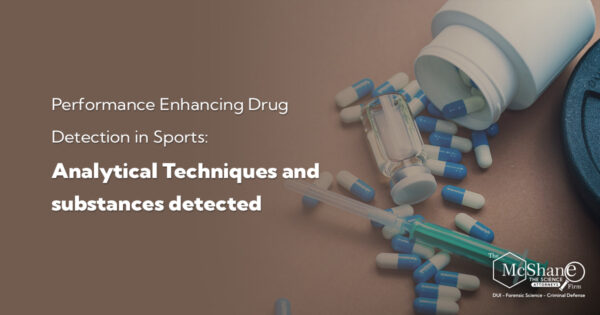Throughout the history of drug testing in sports, various analytical techniques have been used to detect an ever-evolving range of performance-enhancing substances. Some of the key techniques and substances tested for include:

- Gas Chromatography-Mass Spectrometry (GC-MS): GC-MS is a widely used analytical technique for detecting a range of substances, including anabolic steroids, stimulants, and masking agents. The technique involves vaporizing the sample, separating its components using gas chromatography, and then identifying the components based on their mass spectra. GC-MS is highly sensitive and selective, making it a valuable tool for detecting minute quantities of banned substances.
- Liquid Chromatography-Tandem Mass Spectrometry (LC-MS/MS): LC-MS/MS is another powerful technique used for detecting substances such as erythropoietin (EPO), peptide hormones, and diuretics. This method combines the separation capabilities of liquid chromatography with the sensitivity and selectivity of mass spectrometry. By incorporating multiple stages of mass spectrometry (tandem mass spectrometry), LC-MS/MS can provide highly accurate identification of target compounds and their metabolites in complex samples.
- Indirect Enzyme-Linked Immunosorbent Assay (ELISA): ELISA is an immunoassay technique used for the detection of substances like human growth hormone (hGH) and erythropoietin (EPO). This method relies on the specific binding between an antigen (the target substance) and its corresponding antibody. The presence and concentration of the target substance can be determined based on the degree of color change resulting from an enzyme-catalyzed reaction. While ELISA is highly sensitive, it may not be as specific as mass spectrometry-based techniques.
- Carbon Isotope Ratio Mass Spectrometry (CIR-MS): CIR-MS is a specialized technique used to differentiate between endogenous (naturally occurring) and exogenous (synthetic) anabolic steroids. This method involves determining the ratio of carbon-13 to carbon-12 isotopes in a sample, as synthetic steroids typically have a different isotope ratio than their naturally occurring counterparts. CIR-MS has been instrumental in catching athletes who use synthetic testosterone and other anabolic steroids.
- Hematological Profiling: Hematological profiling involves the analysis of an athlete’s blood parameters, such as hemoglobin concentration, hematocrit, and reticulocyte count, to detect blood doping practices like autologous blood transfusions and erythropoiesis-stimulating agents (ESAs). The Athlete Biological Passport (ABP) program, implemented by WADA, uses longitudinal monitoring of hematological parameters to identify abnormal variations in an athlete’s blood profile that may indicate doping.
These analytical techniques have evolved alongside the development of new performance-enhancing substances and methods, and anti-doping organizations continue to refine and expand their testing capabilities. As doping techniques become more sophisticated, the importance of advanced analytical methods and ongoing research in anti-doping science becomes increasingly critical to preserving the integrity of sports.
Here are some general statistics and notable cases to illustrate the prevalence of doping in sports:
- Olympic Games: According to the International Olympic Committee (IOC), more than 130 athletes have been disqualified from the Olympics since 1968 due to positive doping tests. This number includes retroactive disqualifications based on retesting of stored samples using advanced analytical techniques.
- World Anti-Doping Agency (WADA) Statistics: WADA publishes annual statistics on anti-doping rule violations (ADRVs). According to the WADA Anti-Doping Testing Figures Report for 2019, there were 2,297 ADRVs worldwide, with 1,923 (83.7%) resulting from positive test results. These figures represent a wide range of sports, including athletics, cycling, and weightlifting, which tend to have higher numbers of ADRVs. Source: https://www.wada-ama.org/sites/default/files/resources/files/2019_testing_figures_report_0.pdf
- Notable Cases:
- -1998 Tour de France: The Festina cycling team was disqualified after a team car was found to be carrying large quantities of performance-enhancing drugs, including EPO, steroids, and growth hormones. Several other teams withdrew from the race in protest, and the scandal led to numerous doping investigations and policy changes in professional cycling.
- -BALCO Scandal (2003): The Bay Area Laboratory Co-operative (BALCO) was involved in a doping scandal that implicated several high-profile athletes, including Marion Jones, Tim Montgomery, and Dwain Chambers. The investigation revealed the use of previously undetectable substances such as the designer steroid tetrahydrogestrinone (THG).
- -Russian State-Sponsored Doping (2015): The WADA Independent Commission, led by Richard McLaren, exposed a state-sponsored doping program in Russia involving athletes, coaches, and government officials. The investigation led to numerous bans and sanctions on Russian athletes and significantly impacted the country’s participation in international events, including the 2016 Rio Olympics and 2018 Pyeongchang Winter Olympics.
These statistics and cases highlight the ongoing challenge of addressing performance-enhancing drug use in sports. Anti-doping organizations, such as WADA and national anti-doping agencies, continue to improve testing procedures and policies to deter doping and maintain the integrity of sports.


